Taurus 617....hi I just got this and I was wonder about ballistics of a 357 mag coming out of 2 inch snubby??
Defence against two leg threats, and four leg threat. ( not bears)... it will be my self defence gun when I go fishing.
( don't like fishing near the city).
2 inch snubby
72 posts • Page 1 of 5 • 1, 2, 3, 4, 5
Re: 2 inch snubby
It's pretty anemic.
http://www.ballisticsbytheinch.com/357mag.html
Better than .38spc in 2" (which I often carry for 2 legged threat protection).
http://www.ballisticsbytheinch.com/357mag.html
Better than .38spc in 2" (which I often carry for 2 legged threat protection).
Re: 2 inch snubby
With a full power .357 Magnum load, a lot of energy is wasted in the form of blast and flash in anything less than a 4" barrel.
On the other hand, there's still enough left over that it's definitely more effective than an .38 +P, despite what you might hear.
viewtopic.php?f=12&t=2032&start=0#p21745
On the other hand, there's still enough left over that it's definitely more effective than an .38 +P, despite what you might hear.
viewtopic.php?f=12&t=2032&start=0#p21745
-

Pat Cannon - Posts: 3894 [View]
- Joined: Fri Jul 27, 2007 2:32 pm
- Location: South Minneapolis
Re: 2 inch snubby
I see thanks for the info!!!. It was really helpful.
- NinjaMonkey
- Posts: 58 [View]
- Joined: Sun May 10, 2015 9:16 pm
Re: 2 inch snubby
I bought the 685. I consider it a belly gun for close quarters like inside an office or vehicle.
You stick it in their belly and pull the trigger.
You stick it in their belly and pull the trigger.
We reap what we sow. In our case, we have sown our government.
Current moon phase
Current moon phase
-

farmerj - Posts: 4802 [View]
- Joined: Fri Aug 10, 2007 9:11 am
- Location: The edge of the universe in the vertex of time on the space continuum of confusion
Re: 2 inch snubby
I'm not going to be trying to defend a mall or anything with my .38spc (poor ability to hit anything at distance with it), and only having 5 shots also limits your options if it's a mob or active shooter type situation. It's still better than nothing.
One thing I haven't done that I've been meaning to is developing a load with faster powders for the short barrel.
Mine's with me when I'm in my kayak fishing. I'm not afraid of pirates (or jackass teens with a knife ).
). 
One thing I haven't done that I've been meaning to is developing a load with faster powders for the short barrel.
Mine's with me when I'm in my kayak fishing. I'm not afraid of pirates (or jackass teens with a knife
Re: 2 inch snubby
consider travelling.
What is the capacity in some states that you will travel in? For me, the most restrictive is NY. 7 Rounds
What is any ammunition restrictions you might come across. For me, the most restrictive is NJ. No FMJ
So I settled on a 5 shot .357 snubby with LRN.
something is better than Nothing.
What is the capacity in some states that you will travel in? For me, the most restrictive is NY. 7 Rounds
What is any ammunition restrictions you might come across. For me, the most restrictive is NJ. No FMJ
So I settled on a 5 shot .357 snubby with LRN.
something is better than Nothing.
We reap what we sow. In our case, we have sown our government.
Current moon phase
Current moon phase
-

farmerj - Posts: 4802 [View]
- Joined: Fri Aug 10, 2007 9:11 am
- Location: The edge of the universe in the vertex of time on the space continuum of confusion
Re: 2 inch snubby
There's nothing wrong with hard cast lead. All the fancy bullet makers would like you to believe there is so you keep buying their JHP's, but it's been killing elephants for over a hundred years.
Re: 2 inch snubby
This is going to be a big reply, but somebody on another forum asked the exact same question, and seeing as I have a copy of Quickload, I figured I could calculate the ballistics of various cartridges for different barrel lengths. Quickload CANNOT simulate the cylinder gap, so you can expect the real results to be WORSE than the calculations. With a 2" 357 snubby, you are still throwing most of the baby out with the bath water. In a SHTF situation, it's better than nothing, but the ONLY way I would put my life on the line with ballistics this anemic is if I WERE dead. The nice thing about this exercise is that it's all apples to apples, so data from 7 different manuals doesn't cloud the issue.
Okay, I got the results worked out. Briefly, I went to the Hornady handloading manual, and picked out the +P or maximum normal loads listed, and stuffed those variables into Quickload. FWIW, Quickload is a pretty sophisticated program, and its purpose is to allow you to experiment without actually blowing yourself up, which makes it worth a paltry $150 to old mad scientists who got a lot of hospital work left. :yikes:
So, once I got the data loaded and ran the cartridge for the longest barrel length that was to be tested to verify that it was within safe calculated limits, I just re-ran the data for shorter and shorter barrel lengths, since barrel length is a separate variable in this program. I tried to use Power Pistol whenever I could to remove some more variability from this exercise.
The net result is that the comparisons are all apples to apples across the board, so this data is uniformly calculated and presented.
Here's the data, with a few comments to go with. There are definitely some cartridge and barrel length combinations that you want to avoid like the plague!
The 9mm Luger round (9x19 mm) is a pretty straightforward round, and WYSIWYG. It's a small diameter bullet, but the velocity stays good, and the ft-lbs of energy don't precipitously drop off like the next cartridge.
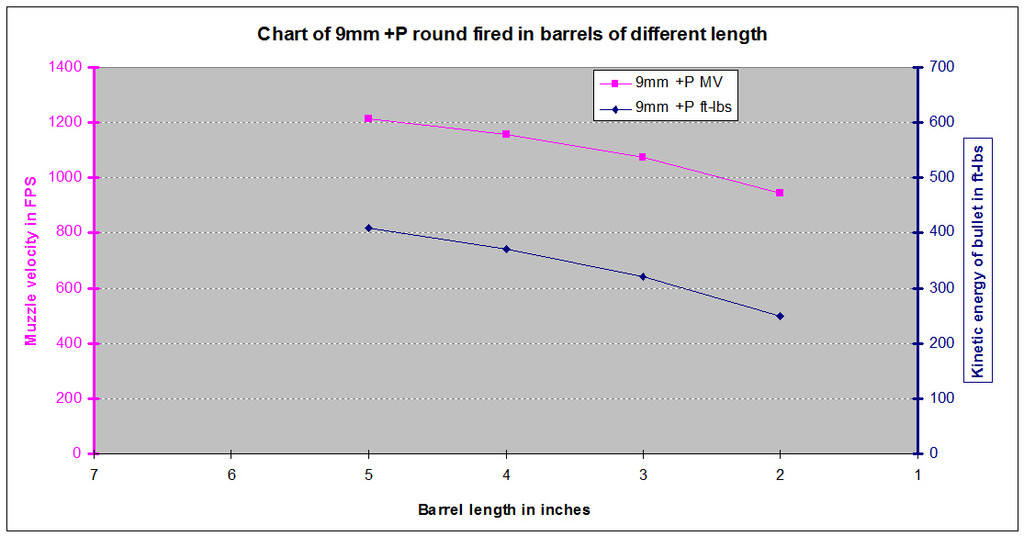
The 38 Special is a nasty surprise in anything shorter than a 5" barrel, which is probably why all the original guns had 5" or 6" barrels!! With a 2" snubby giving you only 600 FPS velocity and 100 ft-lbs of energy, you're getting concealability and giving up nearly all of the stopping power.

The 45 ACP has good solid performance in a 6" to 3" barrel, and there's not much to worry about across the board. There's some additional info on the last graph, and shows that a big, slow bullet is better than what these numbers show..
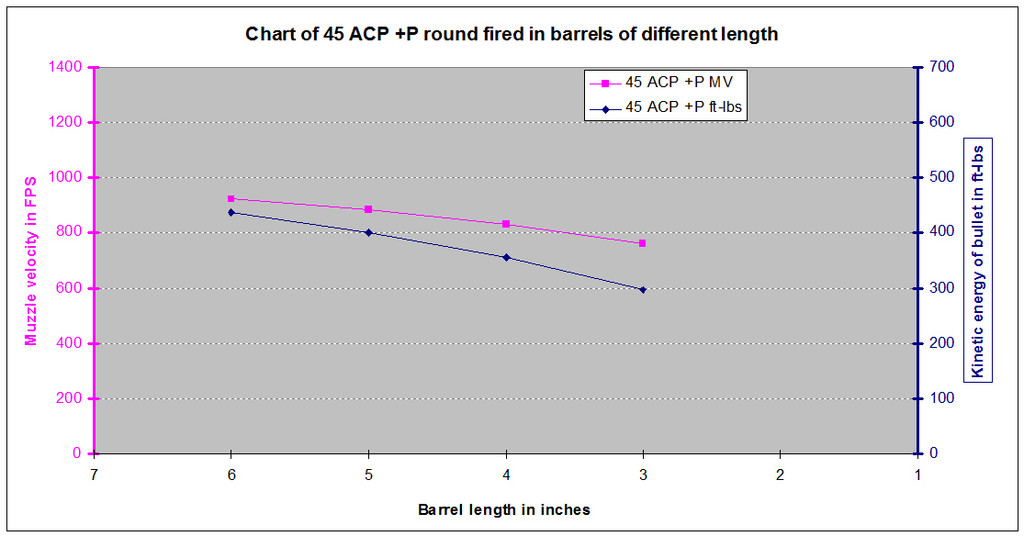
The 357 mag is known for plenty of punch, and generally it delivers the goods. However, as you can see, the stopping power trails off very rapidly with 3" and 2" barrels, with the 2" barrel only giving you 200 ft-lbs of stopping power. That is NOT a reassuring amount of punch when your life is on the line!
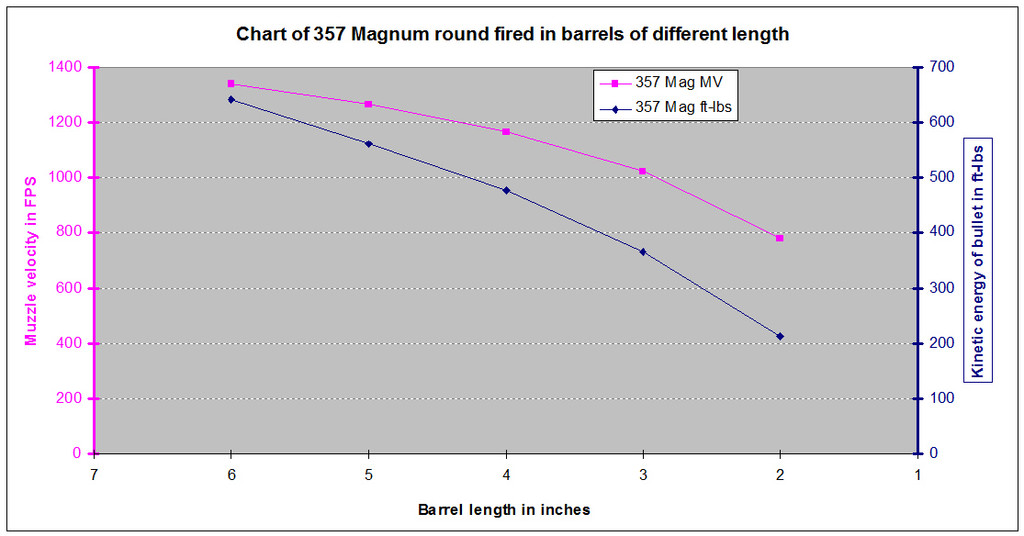
The 40 S&W round is also pretty straightforward, and with a 5, 4, or 3" barrel you stay above 300 ft-lbs of punch.
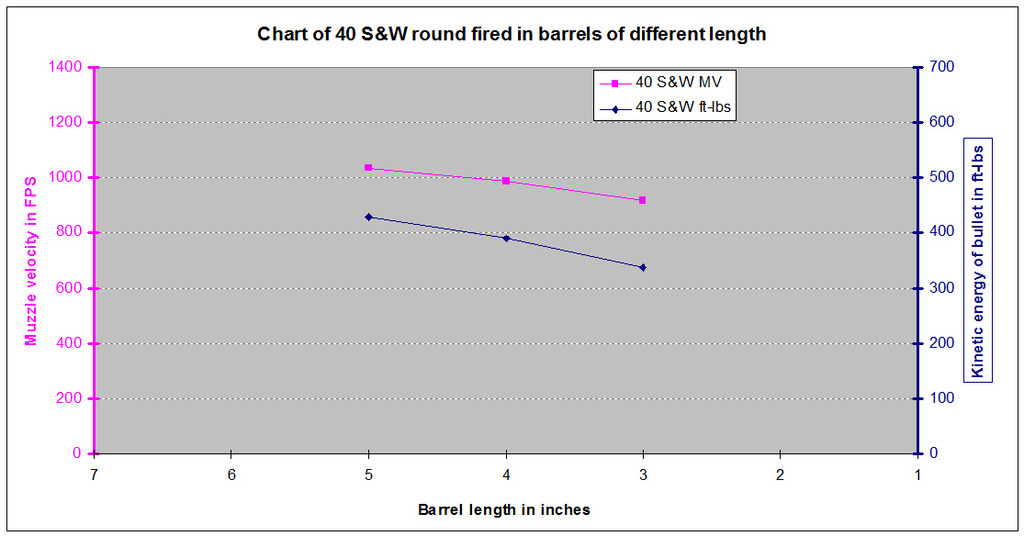
The last chart is the Taylor Knock-Out Factor for the above rounds, because the formula for calculating ft-lbs is an invitation to many snake oil salesman posing as ammunition companies to pull the wool over your eyes and get rich.
Without going into the difference between weight and mass, the formula for ft-lbs is 1/2 the mass of the bullet times the SQUARE of the velocity. The diameter of the bullet isn't even considered!!
The Taylor Knock Out Factor was named after an African big game hunter AND poacher, who had learned that a 220 Swift bullet with a gazillion ft-pounds of energy at 4000 fps wouldn't do diddly squat against a rhino or elephant. The bullet HAD to be close to 1/2" diameter, weigh close to an ounce, and had to going Mach 2 or better.
This explains why the TKO for the 45 ACP is head and shoulders above the other cartridges. In addition, the top end of this chart is around a TKO of 17-18,which is what you have with a full power 44 magnum load using a 240 grain bullet going 1800 FPS out of an 8" barrel. Curiously enough, a 5" barrel 50GI has the same TKO score, with a 50 cal 300 grain bullet going 900 FPS.
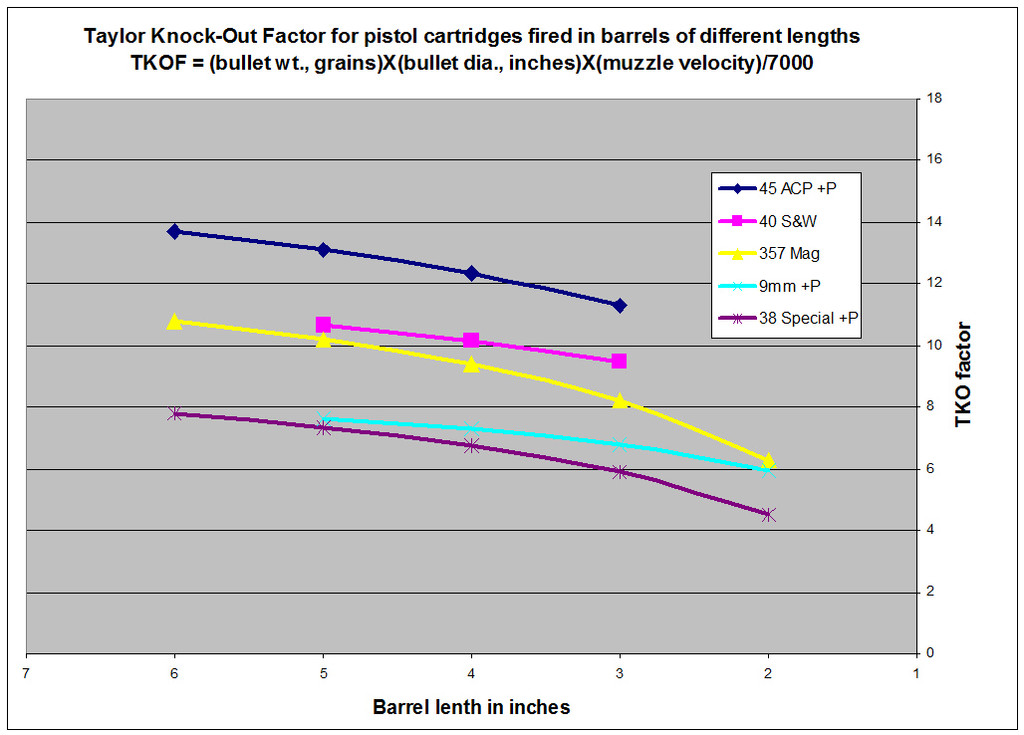
Seeing as I mentioned the 500 Smith snubby in another post, I thought I would add that to the list. Previously I had mentioned that with a 2" barrel 500 (which they DO sell!!) you are losing most of your velocity and hitting power. I was mostly right, and the 2" barrel ft-lbs number is appalling.
In a regular Smith 500 with an 8" barrel, with a 350 grain 50 caliber slug you get 1850 FPS and 2782 ft-lbs, which gives you a fighting chance to stay alive with a brown bear. The Taylor Knock-Out factor is in the mid 40's, which is getting up into African hunting rifle territory. With a 2" barrel, however, the velocity goes from 1892 to 852, so you only have 45% of your velocity left. The ft-lbs goes from 2782 to 564, so with a 2" snubnose Smith 500 you give up 81% of your stopping power, and 564 ft-lbs won't do diddly squat to a half ton of bear!! S&W should be ashamed of themselves for putting a $1K+ booby trap like that on the market.
and 2782 ft-lbs, which gives you a fighting chance to stay alive with a brown bear. The Taylor Knock-Out factor is in the mid 40's, which is getting up into African hunting rifle territory. With a 2" barrel, however, the velocity goes from 1892 to 852, so you only have 45% of your velocity left. The ft-lbs goes from 2782 to 564, so with a 2" snubnose Smith 500 you give up 81% of your stopping power, and 564 ft-lbs won't do diddly squat to a half ton of bear!! S&W should be ashamed of themselves for putting a $1K+ booby trap like that on the market.
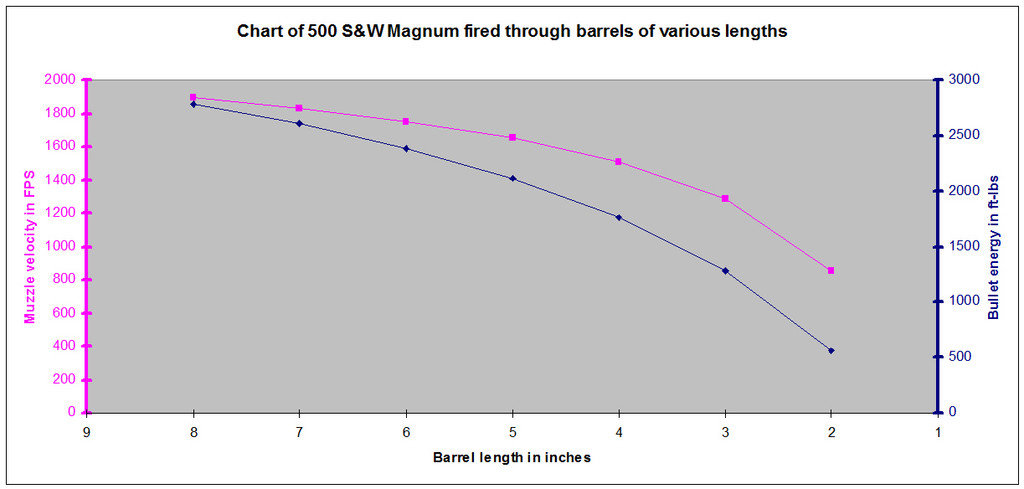
Okay, I got the results worked out. Briefly, I went to the Hornady handloading manual, and picked out the +P or maximum normal loads listed, and stuffed those variables into Quickload. FWIW, Quickload is a pretty sophisticated program, and its purpose is to allow you to experiment without actually blowing yourself up, which makes it worth a paltry $150 to old mad scientists who got a lot of hospital work left. :yikes:
So, once I got the data loaded and ran the cartridge for the longest barrel length that was to be tested to verify that it was within safe calculated limits, I just re-ran the data for shorter and shorter barrel lengths, since barrel length is a separate variable in this program. I tried to use Power Pistol whenever I could to remove some more variability from this exercise.
The net result is that the comparisons are all apples to apples across the board, so this data is uniformly calculated and presented.
Here's the data, with a few comments to go with. There are definitely some cartridge and barrel length combinations that you want to avoid like the plague!
The 9mm Luger round (9x19 mm) is a pretty straightforward round, and WYSIWYG. It's a small diameter bullet, but the velocity stays good, and the ft-lbs of energy don't precipitously drop off like the next cartridge.

The 38 Special is a nasty surprise in anything shorter than a 5" barrel, which is probably why all the original guns had 5" or 6" barrels!! With a 2" snubby giving you only 600 FPS velocity and 100 ft-lbs of energy, you're getting concealability and giving up nearly all of the stopping power.

The 45 ACP has good solid performance in a 6" to 3" barrel, and there's not much to worry about across the board. There's some additional info on the last graph, and shows that a big, slow bullet is better than what these numbers show..

The 357 mag is known for plenty of punch, and generally it delivers the goods. However, as you can see, the stopping power trails off very rapidly with 3" and 2" barrels, with the 2" barrel only giving you 200 ft-lbs of stopping power. That is NOT a reassuring amount of punch when your life is on the line!

The 40 S&W round is also pretty straightforward, and with a 5, 4, or 3" barrel you stay above 300 ft-lbs of punch.

The last chart is the Taylor Knock-Out Factor for the above rounds, because the formula for calculating ft-lbs is an invitation to many snake oil salesman posing as ammunition companies to pull the wool over your eyes and get rich.
Without going into the difference between weight and mass, the formula for ft-lbs is 1/2 the mass of the bullet times the SQUARE of the velocity. The diameter of the bullet isn't even considered!!
The Taylor Knock Out Factor was named after an African big game hunter AND poacher, who had learned that a 220 Swift bullet with a gazillion ft-pounds of energy at 4000 fps wouldn't do diddly squat against a rhino or elephant. The bullet HAD to be close to 1/2" diameter, weigh close to an ounce, and had to going Mach 2 or better.
This explains why the TKO for the 45 ACP is head and shoulders above the other cartridges. In addition, the top end of this chart is around a TKO of 17-18,which is what you have with a full power 44 magnum load using a 240 grain bullet going 1800 FPS out of an 8" barrel. Curiously enough, a 5" barrel 50GI has the same TKO score, with a 50 cal 300 grain bullet going 900 FPS.

Seeing as I mentioned the 500 Smith snubby in another post, I thought I would add that to the list. Previously I had mentioned that with a 2" barrel 500 (which they DO sell!!) you are losing most of your velocity and hitting power. I was mostly right, and the 2" barrel ft-lbs number is appalling.
In a regular Smith 500 with an 8" barrel, with a 350 grain 50 caliber slug you get 1850 FPS

-

Seismic Sam - Gone but not forgotten
- Posts: 5515 [View]
- Joined: Fri Jul 27, 2007 1:02 pm
- Location: Pass By-You, Loosianana
Re: 2 inch snubby
You need to try different powders. 5.0gr of Unique in any .45 I've owned (most have been 4.25" barrels) will ALWAYS exceed 800fps with a 230gr bullet.
QL has been way off before too. There's a lot of people who put their faith in it, and then there's the guys who want to match numbers with the big ammo makers and go off the Res. seeking the same results. There's a few guys I know I'd trust more than the reloading manuals I have, because they've done the grunt work and it's repeatable. QL is a nice starting point, but as they say - every gun is different and you Sam, of all people, should know and qualify your assertions as such. I think QL's barrels suck.
QL has been way off before too. There's a lot of people who put their faith in it, and then there's the guys who want to match numbers with the big ammo makers and go off the Res. seeking the same results. There's a few guys I know I'd trust more than the reloading manuals I have, because they've done the grunt work and it's repeatable. QL is a nice starting point, but as they say - every gun is different and you Sam, of all people, should know and qualify your assertions as such. I think QL's barrels suck.
Re: 2 inch snubby
I carry just factory target 357 loads in my 640 the recoil is moderate compared to my old lcr or my dads stupid air weight 357. With your compensated revolver the blast will be horrible, and I'm not one to say this ever but you'll lose a lot of the velocity with it being compensated or ported.
I'm not saying its bad, I'm just not a fan of compensated handguns.
I'm not saying its bad, I'm just not a fan of compensated handguns.
Last edited by Amazi on Mon Feb 27, 2017 1:30 pm, edited 1 time in total.
Re: 2 inch snubby
You could just bounce the sun off that shiny chrome plating on that pistol into the offenders eyes and blind them! 
ONE* Training LLC - Mapleton, MN
Offering Training in;
NRA Basic Pistol
MN DPS/ BCA Approved Conceal Carry
WI,IA Conceal Carry
NRA LE Firearms Instructor & LEO HR 218 Training
MN DNR Hunter Safety
ASP Expandable Baton
Offering Training in;
NRA Basic Pistol
MN DPS/ BCA Approved Conceal Carry
WI,IA Conceal Carry
NRA LE Firearms Instructor & LEO HR 218 Training
MN DNR Hunter Safety
ASP Expandable Baton
-

wasfuzz - Posts: 777 [View]
- Joined: Sun Oct 23, 2011 7:20 pm
- Location: way down south on the Maple River
Re: 2 inch snubby
Wondering how many people are willing to take a shot from a 2" snubby to prove how anemic it really is.
We reap what we sow. In our case, we have sown our government.
Current moon phase
Current moon phase
-

farmerj - Posts: 4802 [View]
- Joined: Fri Aug 10, 2007 9:11 am
- Location: The edge of the universe in the vertex of time on the space continuum of confusion
Re: 2 inch snubby
farmerj wrote:Wondering how many people are willing to take a shot from a 2" snubby to prove how anemic it really is.
And what exactly does this ridiculous argument have to do with the reality of whether your gun is capable of stopping an attacker or NOT stopping him??
-

Seismic Sam - Gone but not forgotten
- Posts: 5515 [View]
- Joined: Fri Jul 27, 2007 1:02 pm
- Location: Pass By-You, Loosianana
Re: 2 inch snubby
because to truly stop someone/something, One shot, you have to hit the CNS to shut them down.
flat out.
a bad shot with a .500 S&W will be just as ineffective as a bad shot with a .357 out of a 2" snubby.
a 2" snubby in the belly will be just as effective as a a .500 in the belly.
me putting that 2" snubby up against your head will stop you just as dead. 200 ft-lb of force is enough to do the job.
flat out.
a bad shot with a .500 S&W will be just as ineffective as a bad shot with a .357 out of a 2" snubby.
a 2" snubby in the belly will be just as effective as a a .500 in the belly.
me putting that 2" snubby up against your head will stop you just as dead. 200 ft-lb of force is enough to do the job.
We reap what we sow. In our case, we have sown our government.
Current moon phase
Current moon phase
-

farmerj - Posts: 4802 [View]
- Joined: Fri Aug 10, 2007 9:11 am
- Location: The edge of the universe in the vertex of time on the space continuum of confusion
72 posts • Page 1 of 5 • 1, 2, 3, 4, 5
Who is online
Users browsing this forum: No registered users and 15 guests

